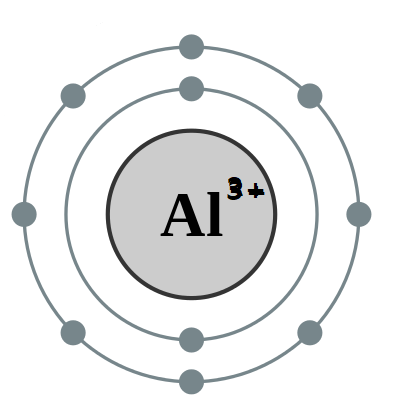
What is the atomic structure of $ A{l^{3 + }} $ ?
Answer
480.6k+ views
Hint: Atomic structure is defined as the structure of the atom which includes the number of neutrons, number of electrons, and number of protons present in the atom. Electrons are negatively charged particles that revolve around the nucleus, which is present at the centre of an atom.
Complete answer:
Aluminium has atomic number 13, so to attain noble gas configuration aluminium loses three electrons leading to the formation of $ A{l^{3 + }} $ cation. For calculating the number of neutrons, electrons, and protons in $ A{l^{3 + }} $ cation:
Step 1: Calculation of the number of neutrons:
For calculating the number of neutrons for any cation or an atom, the difference between the mass number of the atom or cation and the atomic number gives the number of neutrons. So, the mass number of $ A{l^{3 + }} $ + is 27 grams whereas the atomic number of $ A{l^{3 + }} $ cation is 13. Therefore, the number of neutrons in $ A{l^{3 + }} $ ion is
$ 27 - 13 = {\text{ }}14 $
Hence, 14 electrons are present in $ A{l^{3 + }} $ ions.
Step 2: Calculation of the number of electrons:
For calculating the number of electrons in an atom is equal to its atomic number but for cation, the number of electrons is equal to the difference between the atomic number and the number of electrons lost. So, the number of electrons in $ A{l^{3 + }} $ is
$ 13 - 3 = 10 $
Therefore, 10 electrons are present in $ A{l^{3 + }} $ ions.
Step 3: Calculation of the number of protons:
For calculating the number of protons in an atom or cation, the number of protons is equal to the atomic number. Therefore, the number of protons in the $ A{l^{3 + }} $ ion is 13.
Step 4: Stating the electronic configuration:
Electronic configuration of Aluminium is $ 1{s^2}2{s^2}2{p^6}3{s^2}3{p^1} $ .
After removing three electrons the electronic configuration of $ A{l^{3 + }} $ ion is $ 1{s^2}2{s^2}2{p^6} $ .

Note:
$ A{l^{3 + }} $ cation is formed by the removal of three electrons from the aluminium atom, with a +3 charge. An aluminium cation is a monatomic trication. Metals are electropositive i.e. they lose electrons to form a positively charged cation. Aluminium ions are silvery and protected by an oxide coating.
Complete answer:
Aluminium has atomic number 13, so to attain noble gas configuration aluminium loses three electrons leading to the formation of $ A{l^{3 + }} $ cation. For calculating the number of neutrons, electrons, and protons in $ A{l^{3 + }} $ cation:
Step 1: Calculation of the number of neutrons:
For calculating the number of neutrons for any cation or an atom, the difference between the mass number of the atom or cation and the atomic number gives the number of neutrons. So, the mass number of $ A{l^{3 + }} $ + is 27 grams whereas the atomic number of $ A{l^{3 + }} $ cation is 13. Therefore, the number of neutrons in $ A{l^{3 + }} $ ion is
$ 27 - 13 = {\text{ }}14 $
Hence, 14 electrons are present in $ A{l^{3 + }} $ ions.
Step 2: Calculation of the number of electrons:
For calculating the number of electrons in an atom is equal to its atomic number but for cation, the number of electrons is equal to the difference between the atomic number and the number of electrons lost. So, the number of electrons in $ A{l^{3 + }} $ is
$ 13 - 3 = 10 $
Therefore, 10 electrons are present in $ A{l^{3 + }} $ ions.
Step 3: Calculation of the number of protons:
For calculating the number of protons in an atom or cation, the number of protons is equal to the atomic number. Therefore, the number of protons in the $ A{l^{3 + }} $ ion is 13.
Step 4: Stating the electronic configuration:
Electronic configuration of Aluminium is $ 1{s^2}2{s^2}2{p^6}3{s^2}3{p^1} $ .
After removing three electrons the electronic configuration of $ A{l^{3 + }} $ ion is $ 1{s^2}2{s^2}2{p^6} $ .

Note:
$ A{l^{3 + }} $ cation is formed by the removal of three electrons from the aluminium atom, with a +3 charge. An aluminium cation is a monatomic trication. Metals are electropositive i.e. they lose electrons to form a positively charged cation. Aluminium ions are silvery and protected by an oxide coating.
Recently Updated Pages
Why are manures considered better than fertilizers class 11 biology CBSE

Find the coordinates of the midpoint of the line segment class 11 maths CBSE

Distinguish between static friction limiting friction class 11 physics CBSE

The Chairman of the constituent Assembly was A Jawaharlal class 11 social science CBSE

The first National Commission on Labour NCL submitted class 11 social science CBSE

Number of all subshell of n + l 7 is A 4 B 5 C 6 D class 11 chemistry CBSE

Trending doubts
Differentiate between an exothermic and an endothermic class 11 chemistry CBSE

10 examples of friction in our daily life

One Metric ton is equal to kg A 10000 B 1000 C 100 class 11 physics CBSE

Difference Between Prokaryotic Cells and Eukaryotic Cells

1 Quintal is equal to a 110 kg b 10 kg c 100kg d 1000 class 11 physics CBSE

State the laws of reflection of light




